Chemical systems and industry: Identify and describe the impact of scientific knowledge of the hydrosphere on the quality of human, environmental, and socio-economic development
Unit 2: Water pollution
Emma Harrage
Unit outcomes
By the end of this unit you will be able to:
- Understand what water pollution is.
- Identify the main causes:
- industry, including mining
- agriculture
- human activities.
What you should know
Before you start this unit, make sure you can:
- Understand the importance of the hydrosphere, as covered in Subject outcome 7.1, Unit 1.
Note
Before you begin this unit, please watch the video by Netflix called World’s Water Crisis (Duration: 18.42).
Introduction
It should be clear by now that the hydrosphere plays an extremely important role in the survival of life on Earth and that the unique properties of water allow various important chemical processes to take place which would otherwise not be possible. Unfortunately for us however, there are many factors that threaten our hydrosphere and most of these threats are from human activities.
Water pollution occurs when water is contaminated with substances which negatively affect the ecosystem within the body of water or contaminate a source of drinking water. Only 1% of the water found on Earth is available and suitable for drinking, so it is very precious. Farming, mining, and industries commonly pollute our water supplies.
Threats to the hydrosphere
When we think of water , we sometimes only think of things like plastic, bottles, oil and so on. But any chemical that is present in the hydrosphere in an amount that is not what it should be is a . Animals and plants that live in the Earth’s water bodies are specially adapted to surviving within a certain range of conditions. If these conditions are changed (e.g. through pollution), these organisms may not be able to survive. Pollution then, can affect entire aquatic ecosystems. The most common forms of pollution in the hydrosphere are waste products from humans and from industries like mining and agriculture. Two common ingredients in fertilisers are and which are soluble in water and can runoff the land which causes . Mining for precious metals can release toxic trace elements such as aluminium, mercury and copper into water systems. Acidic water, called , can also enter water systems.
Water pollution is not limited to chemicals. Many industrial processes generate heat and use large amounts of water for cooling, which may be taken from the nearest river or lake. It is then returned to its source, possibly at a higher temperature if it has been insufficiently cooled beforehand. This artificial warming may have a damaging effect on local ecosystems because aquatic organisms do not usually adapt well to rapid temperature changes. Oxygen solubility decreases with rising temperatures, putting species requiring high oxygen levels at risk.
Pollution in a water system not only affects drinking water but also affects organisms that live in the water and can affect human food sources.
Humans continue to use more and more water to the point where water consumption is fast approaching the amount of water that is available. The situation is a serious one, particularly in countries like South Africa which are naturally dry and where water resources are limited. It is estimated that between 2020 and 2040, water supplies in South Africa will no longer be able to meet the growing demand for water in this country. This is partly due to population growth, and climate change, but also because of the increasing needs of industries as they expand and develop.
More than 80 percent of the world’s flows back into the environment without being treated or reused, according to the United Nations. In some least-developed countries, the figure tops 95 percent.
Human sewage
Used water is wastewater. It comes from our sinks, showers, and toilets as sewage.
Untreated human sewage leaks into water systems through broken pipes, inadequate sanitation systems or by the sewage system becoming flooded with storm water. Human sewage teems with bacteria which can cause diseases including hepatitis, cholera and diarrheal diseases caused by E.Coli and salmonella bacteria and viruses called rotaviruses which cause acute diarrhoea in children. In 2017, 5.4 million children died from diarrheal disease. Diarrheal diseases are the third leading cause of child mortality globally.
Agricultural pollution
Agricultural pollution refers to the by-products of farming practices that result in contamination or degradation of the environment and surrounding ecosystems. Management practices play a crucial role in the amount and impact of these pollutants. There are several sources of agricultural pollutants which can cause water pollution, but , and animal are the three main contributors. Most agricultural pollutants enter water sources by runoff or .
Fertilisers
Fertilisers are used to provide crops with additional sources of nutrients, such as nitrates and phosphates to promote plant growth and increase crop yields. While they are beneficial for plant growth, they can also pose risks to human and ecological health.
The number of plants, , and in a lake, pond or other water body will increase with an increased supply of nutrients and the increase in growth is not healthy for water resources.
Eutrophication is when a water body becomes abundant in aquatic plants resulting in low oxygen content.
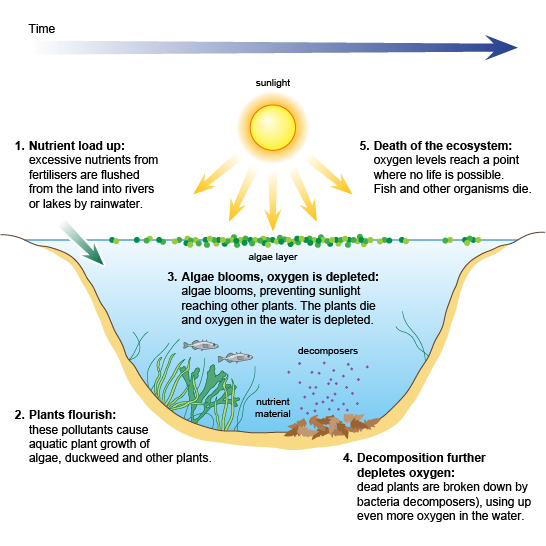
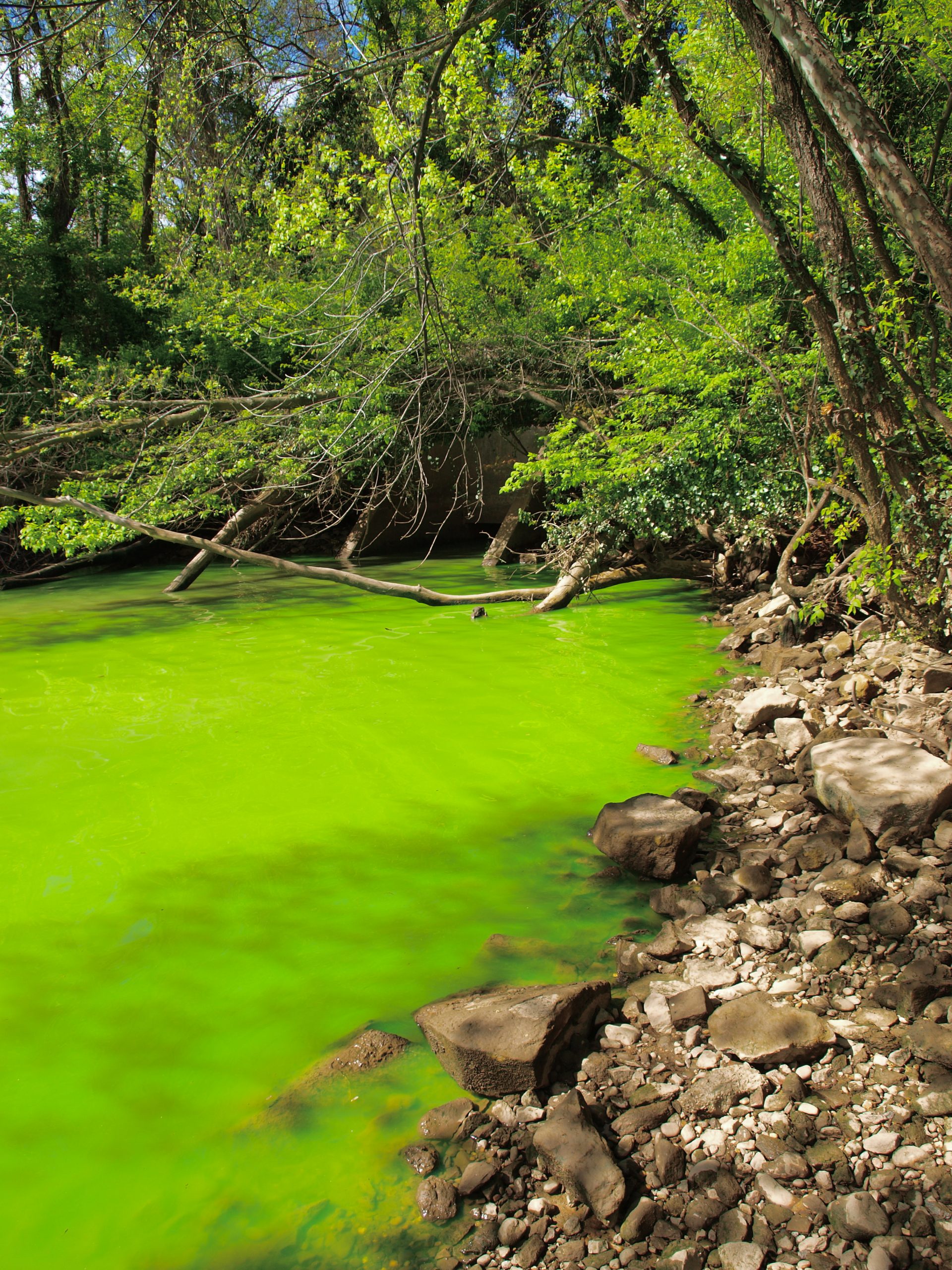
As the aquatic plants die, microbes use the organic matter as a food source. Once again, the microbes respire and reproduce, using up the oxygen in the water. Any increase in the amount of aquatic plant growth will result in a reduced dissolved oxygen content of the water body, eventually suffocating fish and other aquatic species. The resulting dead fish and other aquatic species degrade the water quality and cause unpleasant odours.
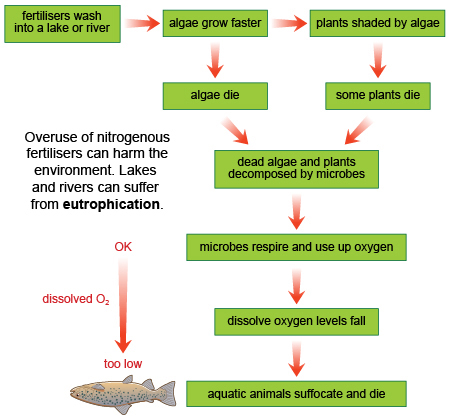
Note
To learn more about this, watch the video called What is Eutrophication by Fuse Schools (Duration: 1.54).
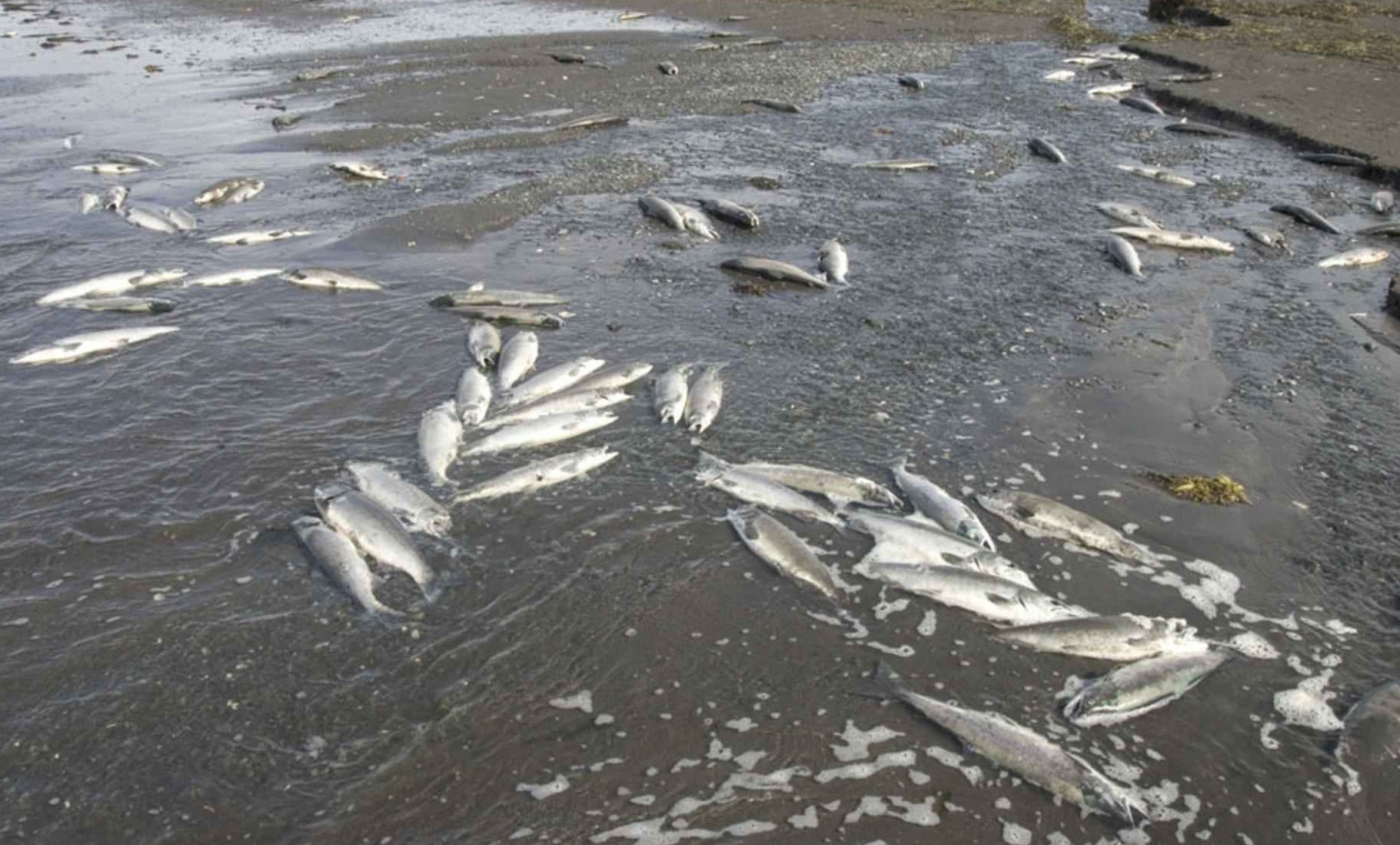
Pesticides
Pesticides are used in farming to kill pests, weeds and insects which cause damage to crops. Pesticides can accumulate in the soil and depending on the amount of rainfall and/or irrigation, these pesticides leach into ground water sources and pollute the water.
Animal manure
Animal manure contains various toxins that pollute water. These are:
- nitrates which are toxic to both humans and animals. If these are in high concentration in drinking water, they cause a disease called methemoglobinemia which interferes with oxygen uptake in the circulatory system.
- ammonia-contaminated runoff, which is toxic to aquatic life. Fish are relatively sensitive to ammonia in water and high levels of ammonia will kill them. Ammonia toxicity also affects the diversity of the species, like water striders, that can live on the surface of the water.
- bacteria, viruses, parasites, and fungi from manure. These enter water systems and some of these organisms can cause diseases in both humans and animals.
Industrial pollution
There are various industries that cause pollution, for example the mining and metallurgical industries, power generating plants, manufacturing factories and processing industries.
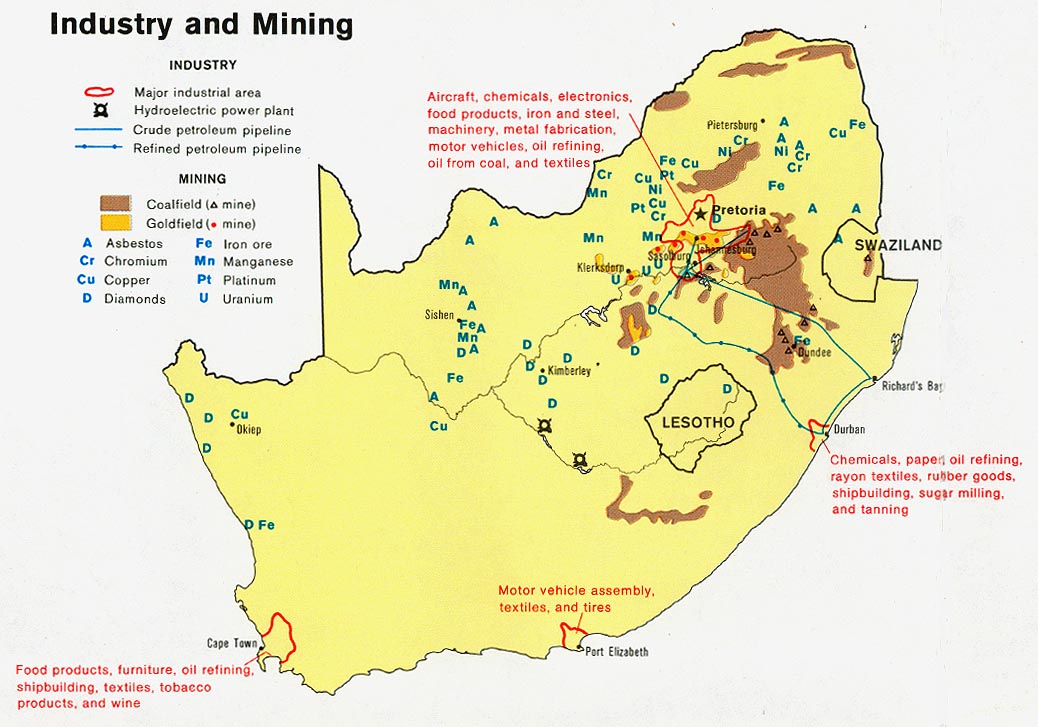
There are also different types of industrial pollution.
- Wastewater is water that has been used in processing or for cleaning equipment and has thereby become contaminated with pollutants. This water is then put back into water sources without being treated. Some by-products of industrial processes are polluting, such as the toxic compounds like Butanoic acid ([latex]\scriptsize {{\text{C}}_{\text{4}}}{{\text{H}}_{\text{4}}}{{\text{O}}_{\text{2}}}[/latex]) produced in the manufacture of certain , or the acidic sulfur dioxide ([latex]\scriptsize \text{S}{{\text{O}}_{\text{2}}}[/latex]) produced by burning coal which is released from the cleaning of power station chimneys.
- Many paper and pulp industries use chlorine as a bleaching agent. The chlorine combines with organic compounds in the wood to make several hazardous compounds.
- The chemical industry has produced thousands of synthetic compounds like High-Density Polyethylene (HDPE), polyethylene Terephthalate (PET or PETE or Polyester) which is used to make plastic bottles, and polystyrene which is used to make take away food containers. These compounds are , which means they do not occur in nature and may take a long time to break down in the environment by microbial action. When they break down, toxins can leach out and pollute water systems.
.
Paper products, however, are made from cellulose, a natural material, and are therefore biodegradable If we compare the rate of decay of a paper bag and a plastic bag, the paper bag will take two to five months to rot away, but the plastic bag will take 50 years to breakdown into tiny pieces of plastic. Other everyday items that contain xenobiotics and take years to break down include:
.
Foamed plastic cup: 50 years
Cigarette filter: 10 years
Disposable nappy: 450 years
Plastic bottle: 450 years
Fishing line: 600 years.
Figure 6: Types of plastics and their uses - Mining is a significant contributor to water pollution, especially here in South Africa as we have a wealth of minerals. Water-pollution problems caused by mining include acid mine drainage (AMD), metal contamination, and increased sediment levels in streams. Sources can include active or abandoned surface and underground mines, processing plants, waste-disposal areas, haulage roads, or tailings ponds. Sediments, typically from increased soil erosion, cause the smothering of streambeds. This siltation affects fisheries, swimming, domestic water supply, irrigation, and other uses of streams.
Note
South Africa is the world’s largest producers of chromium, manganese, platinum, vanadium and andalusite; and the second largest producer of ilmenite, palladium, rutile, and zirconium. We are the third largest coal exporter, fifth largest diamond producer and seventh largest iron ore producer. We are currently fifth on the list of gold producers.
Metal contamination from mining
For every gram of gold produced, gold mines release about two grams of mercury into the environment. Together, gold mines release about 1000 tons of mercury into the environment each year, or 35 percent of man-made mercury pollution. Mercury is extremely harmful to human health. The amount of mercury vapour released by mining activities has been proven to damage the kidneys, liver, brain, heart, lungs, colon, and immune system. Chronic exposure to mercury may result in fatigue, weight loss, tremors, and changes in behaviour. In children and developing foetuses, mercury can impair neurological development.
Unfortunately, mercury can in aquatic food chains. Mercury is absorbed by plant plankton and then bioaccumulates up the food chain in increasing concentrations. People who eat contaminated fish may get mercury poisoning.

Animal plankton will eat lots of plant plankton and absorb the mercury from the plants. A small fish will eat lots of animal plankton and absorb the mercury from the animal plankton. The tuna will eat many small fish and absorb lots of mercury. A person eats lots of tuna and will become ill because of all the mercury he or she has consumed from the tuna.
Mercury damages the reproductive and nervous systems of mammals – including humans!
Note
To consolidate your understanding of water pollution, you can watch this video called What is water pollution? by Fuse Schools (Duration: 5.29).
Acid mine drainage from mining
When mineral deposits that contain sulfides are mined, they have the potential to produce acid mine drainage (AMD). This includes the mining of coal, copper, gold, silver, zinc, lead, and uranium. Acid mine drainage impacts stream and river ecosystems through acidity, ferric ion ([latex]\scriptsize \text{F}{{\text{e}}^{{3+}}}[/latex]) precipitation, oxygen depletion, and the release of heavy metals associated with coal and metal mining, such as aluminium, zinc, and manganese. The mineral pyrite, more commonly known as “fool’s gold”, is iron disulfide ([latex]\scriptsize \text{Fe}{{\text{S}}_{2}}[/latex]). Pyrite is one of the most important sulfides found in the waste rock of mines. When exposed to water and oxygen, it can react to form sulfuric acid ([latex]\scriptsize {{\text{H}}_{\text{2}}}\text{S}{{\text{O}}_{\text{4}}}[/latex]). The reaction is summarised below:
[latex]\scriptsize \text{2Fe}{{\text{S}}_{2}}\text{+7}{{\text{O}}_{2}}\text{+2}{{\text{H}}_{2}}\text{O }\to \text{ 2FeS}{{\text{O}}_{4}}\text{+2}{{\text{H}}_{2}}\text{S}{{\text{O}}_{4}}[/latex]
Pyrite + Oxygen + Water → Ferrous Sulfate + Sulfuric Acid


The dangers increase when this acidic water runs over rocks and strips out other embedded heavy metals. Rivers and streams can become contaminated with metals such as cadmium, arsenic, lead, and iron. Cadmium has been linked to liver disease, while arsenic can cause skin cancer and tumours. Lead poisoning can cause learning disabilities and impaired development in children.
Production of AMD can occur long after mines have been abandoned if piles of waste rock are in contact with air and water. The red colour often seen in streams receiving acid mine drainage is a stain on the rocks called ferrous hydroxide [latex]\scriptsize \text{Fe(OH}{{\text{)}}_{3}}[/latex].

The precipitate forms as the AMD becomes neutralised. At low pH values, the metal ions remain soluble. When the pH rises, the iron oxidises and precipitates out. The precipitates can be harmful to aquatic life. The clumps reduce the amount of light that can penetrate the water, affecting photosynthesis and visibility for animal life. Furthermore, when the precipitate settles, it blankets the stream bed, smothering the bottom-dwellers and their food resources.
Note
Follow this link to view photographs taken of the effects of acidic rivers in South Africa.
A neutral pH has a value of 7. Any sample that reads below a pH of 7 is characterised as being acidic. Anything greater than 7 is described as being basic. The more acidic the water is, the better it is at eroding mining slag, rocks, and other materials. The water then transports the contaminated mine materials to nearby rivers before eventually depositing the materials downstream. Some mine drainage has been seen to have pH in the 2.5-4 range.
In Gauteng, around Carletonville, Krugersdorp, Johannesburg, and Ekurhuleni there are large gold mine dumps, which look like yellow mountains. The dumps are excavated rock and soil from when gold was mined in those areas. These mine dumps contain traces of gold, iron, lead, arsenic and mercury, all of which leach out of the dumps into the surrounding water systems.


Possibly more worrying, and more dangerous, is the fact that these dumps have a high concentration of uranium. This uranium is radioactive and is blown by wind with the dust off the dumps, and when inhaled it causes a variety of respitory problems including cancer and asthma. Uranium occurs naturally alongside gold reefs, and for every tonne of gold mined in the Witwatersrand gold fields, it is estimated that 10 tonnes of uranium were also mined. For most of the gold mines, uranium was merely a waste product and therefore dumped without being recovered.
Without the proper precautions in place, ore-bearing uranium leaches from the tailings and enters surrounding streams and wetlands as run-off. A similar process occurs in abandoned mines underground, with polluted water seeping through porous rock as the mines flood.
As well as cancer, high radioactive levels are linked to other health risks such as Parkinson’s disease, Alzheimer’s, neurotoxic syndromes, and growth deficiencies.
Acidic water and water which is polluted with heavy metals and uranium is not suitable as drinking water, nor can it be used to irrigate crops.
Note
You can find out more about acid mine drainage in South Africa by reading this case study: Africa Groundwater Atlas. 2019. Case study: Acid mine drainage in South Africa. British Geological Survey.
Summary
In this unit you have learnt the following:
- Water is a precious resource, and only 1% of the water available on Earth is fresh water. Despite the importance of the hydrosphere, a number of factors threaten it. These include overuse of water, and pollution.
- Water resources need protecting from pollution.
- Water is not pure, but has many substances dissolved in it.
- Human sewage, mining, agriculture, and industry are the main sources of water pollution.
- Mining can cause acid mine drainage, which acidifies water. This can cause metals to leach into water sources which cause serious health problems.
- Agriculture practices include the use of fertilisers, pesticides and herbicides which can pollute water sources.
- Industrial practices can pollute water sources with dissolved chemicals, with insoluble solids including plastics, as well as heat.
Unit 2: Assessment
Suggested time to complete: 30 minutes
- Which of the following are the primary causes of water pollution?
- Plants
- Animals
- Human activities
- None of these
- What is the main cause of eutrophication?
- Fertilisers
- Flooding
- Boat traffic
- Photosynthesis
- Eutrophication is less likely to occur in areas that:
- are surrounded by fertilised land.
- are not surrounded by fertilised land.
- have lots of fish.
- already have algal blooms.
- Local farmers have expanded the grazing area of their cattle. How will this impact the river that runs along with their lands?
- Animal waste will run into the river with every rainfall.
- This will not impact the river significantly.
- Animal waste will decompose and add important nutrients to the river.
- Cattle will pollute the river by using it as a source of water.
- .
- What constitutes water pollution?
- List the major categories of water pollutants.
- .
- Give a definition for the following:
- fertiliser
- herbicide
- pesticide
- In what industries are the chemicals above used, and briefly explain how they can pollute a water system.
- Give a definition for the following:
- Using the diagram below, write a sentence to describe each stage of eutrophication.

- Describe how mercury bioaccumulates in the aquatic food chain and explain what impact this has on people who eat tuna fish.

- It was reported in a newspaper article in 2015 that Johannesburg pumps most of its drinking water from Lesotho despite having large ground water reserves.
.

.
Write a short paragraph to explain why this would be the case.
The full solutions are at the end of the unit.
Unit 2: Solutions
Unit 2: Assessment
- c
- a
- b
- a
- .
- Water pollution occurs when any water source becomes contaminated.
- The major categories of water pollution include:
- Sewage
- Agricultural pollution
- Mining pollution
- Chemical pollution
- .
- .
- a chemical compound added to crops to increase growth
- a chemical compound used to kill weeds
- a chemical compound used to kill insects
- Fertilisers are used in agriculture. They can run off into water systems and cause eutrophication. Herbicides and pesticides are also used in agriculture and if they run off into water systems they cause water pollution.
- .
- .
1. Excessive nutrients from fertilisers wash into a water system.
2. Plants including algae grow rapidly.
3. The algae bloom, which blocks sunlight from reaching plants which then die, depleting the water of oxygen.
4. Decomposition of the dead plants by microbes uses up more oxygen.
5. The ecosystem in the water body dies because of a lack of oxygen. - Mercury accumulates up the food chain, because it accumulates in organisms. Larger organisms need to eat many smaller organisms so they will consume more mercury.
.
Mercury will be present in the water, and this will be absorbed by the plant plankton.
.
Animal plankton will eat lots of plant plankton and absorb the mercury from the plants.
.
A small fish will eat lots of animal plankton and absorb the mercury from the animal plankton.
.
The tuna will eat many small fish and absorb even more mercury.
.
A person eats lots of tuna and will become ill because of all the mercury he or she has consumed from the tuna. - Johannesburg needs to use water pumped from Lesotho because of water contamination and pollution. This pollution is from mines around Johannesburg. The water is contaminated with heavy metals such as lead and cadmium and chemicals such as arsenic and mercury. All these cause health problems. Uranium also leaches into the streams and rivers. Acid mine drainage, which causes the water to become more acidic than vinegar, is also caused by the production of iron sulfide due to reactions with the by-products of mining. This turns water systems orange and destroys the ecosystem.
Back to Exercise Unit 2: Assessment
Media Attributions
- QR_Code_PSL2SO71U2_1
- Fig 1 © BBC is licensed under a CC BY-SA (Attribution ShareAlike) license
- Fig 2 © Alexandr Trubetskoy is licensed under a CC BY-SA (Attribution ShareAlike) license
- 04_chemistry © BBC is licensed under a CC BY-SA (Attribution ShareAlike) license
- QR_Code_PSL2SO71U2_2
- Fig 4 © USFWS is licensed under a CC0 (Creative Commons Zero) license
- Fig 5 © CIA is licensed under a CC BY-SA (Attribution ShareAlike) license
- Fig 6 © IGEM is licensed under a CC0 (Creative Commons Zero) license
- Fig 7 © DHET is licensed under a CC BY (Attribution) license
- QR_Code_PSL2SO71U2_3
- Fig 8 © DHET is licensed under a CC BY (Attribution) license
- Fig 9 © DHET is licensed under a CC BY (Attribution) license
- Fig 10 © NASA is licensed under a Public Domain license
- QR_Code_PSL2SO71U2_1 (2)
- Fig 11 © environment is licensed under a All Rights Reserved license
- Fig 12 © NJR ZA is licensed under a CC BY-SA (Attribution ShareAlike) license
- QR_Code_PSL2SO71U2_4
- Fig 13 © DHET is licensed under a CC BY (Attribution) license
- Fig 14 © DHET is licensed under a CC BY (Attribution) license
- QR_Code_PSL2SO71U2_5
the introduction of a substance which is harmful or poisonous to the environment
a substance or object which is harmful to the environment
chemical compounds made up of nitrogen and oxygen used in fertiliser to increase plant growth
chemical compounds made up of phosphorous and oxygen used in fertiliser to increase plant growth
dense plant growth in a water system which removes light from the water system causing plants to die
the outflow of acidic water from metal mines or coal mines
water which has been used and may contain pollutants
chemical compounds used to kill insects
nutritional compounds which are used to encourage plant growth
faecal matter from animals, which is sometimes used as fertiliser
the extraction of a mineral or compound from a solid substance when it comes into contact with a liquid
microscopic green organisms which live in water and carry out photosynthesis
tiny organisms such as bacteria
chemical compounds which are used to kill weeds
a chemical substance which is not produced naturally
to build-up in a living organism





